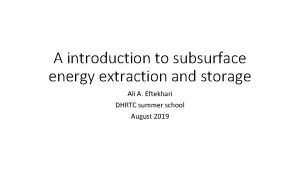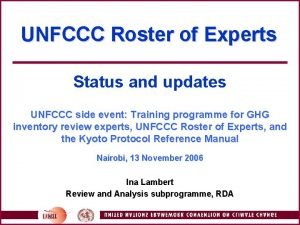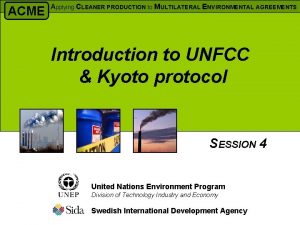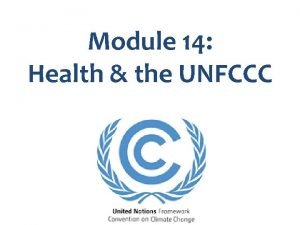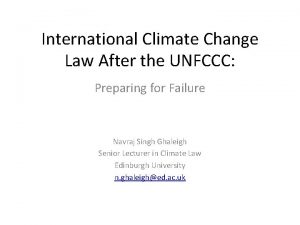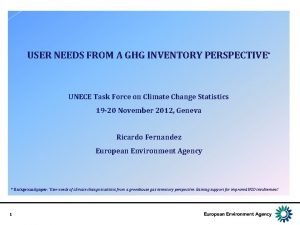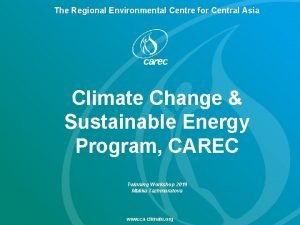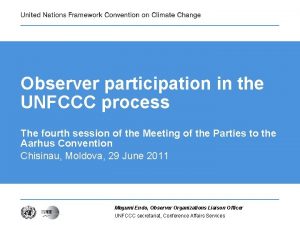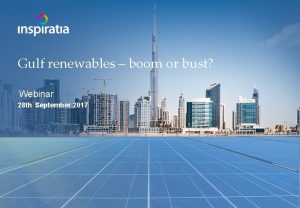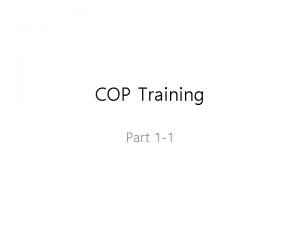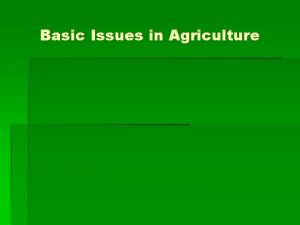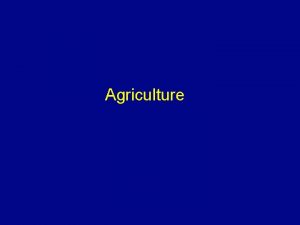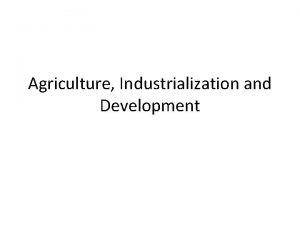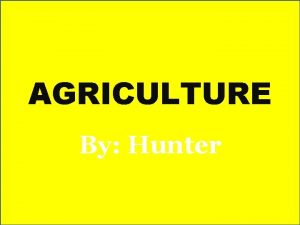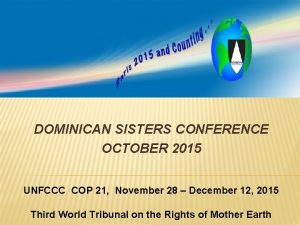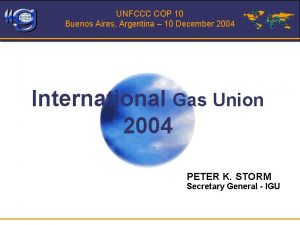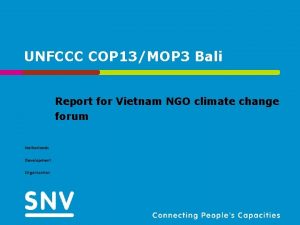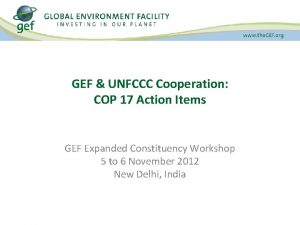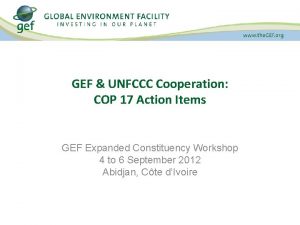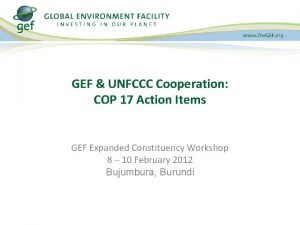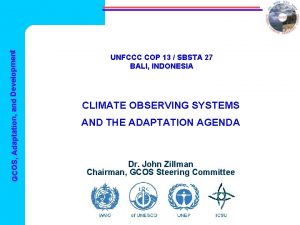Agriculture in the UNFCCC COP 21 Paris JOHN























- Slides: 23

Agriculture in the UNFCCC COP 21 (Paris) JOHN MULDOWNEY JOHN. MULDOWNEY@AGRICULTURE. GOV. IE DEPARTMENT OF AGRICULTURE, FOOD AND THE MARINE JANUARY 2016

GHG emissions accelerate despite reduction efforts. Most emission growth is CO 2 from fossil fuel combustion and industrial processes.

Greenhouse gas emissions by economic sector (AR 5)

Agriculture and climate nexus in a world wide context: Agriculture and forestry serve multiple objectives; food production, bioenergy, materials o Agriculture will have to feed a growing and wealthier global population of nine billion people by 2050 will require a 60% increase in global food production (2013). Agriculture and Forestry face many challenges o Degrading soils, extreme weather events. . o Changes in yields and productivity leading to reduced GDP from agriculture and fluctuations of world market prices, increased risk of hunger… o Competition for land between activities o Competition for scarce water resources

UNFCCC Climate Change is recognised as the greatest threat to the planet and the greatest challenge facing humanity UNFCCC objective is to stabilise atmospheric GHG concentrations at a level that would avoid dangerous human interference with the climate system

UNFCCC Adopted in 1992, entered into force in 1994 195 Parties Bodies SBI SBSTA Other temporary bodies Agreements Kyoto Protocol 1997, into force 2005, 192 Parties

Article 2 of the UNFCCC Convention “The ultimate objective of this Convention and any related legal instruments that the Conference of the Parties may adopt is to achieve, in accordance with the relevant provisions of the Convention, stabilization of greenhouse gas concentrations in the atmosphere at a level that would prevent dangerous anthropogenic interference with the climate system. Such a level should be achieved within a time frame sufficient to allow ecosystems to adapt naturally to climate change, to ensure that food production is not threatened and to enable economic development to proceed in a sustainable manner. ”

Where do we stand in SBSTA? 4 Workshops in 2015 / 2016 (a) Development of early warning systems and contingency plans in relation to extreme weather events and its effects such as desertification, drought, floods, landslides, storm surge, soil erosion, and saline water intrusion; (b) Assessment of risk and vulnerability of agricultural systems to different climate change scenarios at regional, national and local levels, including but not limited to pests and diseases; (c) Identification of adaptation measures, taking into account the diversity of the agricultural systems, indigenous knowledge systems and the differences in scale as well as possible co-benefits and sharing experiences in research and development and on the ground activities, including socioeconomic, environmental and gender aspects; (d) Identification and assessment of agricultural practices and technologies to enhance productivity in a sustainable manner, food security and resilience, considering the differences in agro-ecological zones and farming systems, such as different grassland cropland practices and systems 9 submissions made : -New Zealand -Brazil -Uruguay -Africa Group (Sudan) -Republic of Korea -South Africa -USA -Chile -EU => Highlighting mainly food production

Where do we stand in the Paris Agreement Food Security, ending Hunger and Food Production Preamble - ‘Recognizing the fundamental priority of safeguarding food security and ending hunger, and the particular vulnerabilities of food production systems to the adverse impacts of climate change, ’ Article 2, 1 c – ‘Increasing the ability to adapt to the adverse impacts of climate change and foster climate resilience and low greenhouse gas emissions development, in a manner that does not threaten food production; ’ Ambition Article 2, 1 a – ‘Holding the increase in the global average temperature to well below 2 °C above pre-industrial levels and to pursue efforts to limit the temperature increase to 1. 5 °C above pre-industrial levels, recognizing that this would significantly reduce the risks and impacts of climate change; ’

A historic Agreement • A new chapter in international climate governance and action • A win for multilateralism • A strong signal to policy makers, investors and businesses • Great example of EU unity and leadership

The first major multilateral deal of the 21 st century Agreement Decisions Lima-Paris Action Agenda • Common ambition • Commitments for all • Solidarity package FOREST RESILIENCE TRANSPORT PRIVATE FINANCE AGRICULTURE BUILDING SHORT-LIVED CLIMATE POLLUTANTS RENEWABLE ENERGY CITIES & SUBNATIONALS ENERGY EFFICIENCY & ACCESS INNOVATION BUSINESS

Global goal Ambition Well below 2°C + Efforts to stay below 1. 5°C Pathway to low-emission future • • Global peaking as soon as possible Rapid reductions Balance between emissions and sinks after 2050 - based on science Parties to formulate long-term (2050) low emissions strategies by 2020 Global pathway means international transport is included Fairness aspects

Successful INDC process before Paris Ambition Aggregate global emissions: UNFCCC Synthesis report UNEP Gap report INDC more than numbers: IEA World Energy Outlook: decoupling MILES IDDRI report: air pollution, energy security benefits Parties with INDCs covering periods up to 2030 invited to communicate or update by 2020, following a 2018 facilitative dialogue => INDCs from 187 Parties

Impact of INDCs on global emissions Ambition Source: EC-JRC

Main Elements of Paris Agreement Commitments Emissions reductions Transparency & accountability Global stocktake – 2018, 2023, 2028+ Solidarity Finance Adaptation Loss & damage Technology & Capacity Building Pre-2020 action

The EU INDC Submitted on the 6 th March 2015 An absolute emission reduction target of at least 40% versus 1990 The land use sector is included yet "How" still to be decided

EU Climate Policy in the short term: key policy instruments GHG Target in 2020: -20% compared to 1990 -14% compared to 2005 EU Emissions Trading System (ETS) -21% compared to 2005 CH 4 and N 2 O from agriculture included CO 2 from LULUCF NOT included Non ETS sectors (transport, buildings, waste, agriculture) -10% compared to 2005 27 Member State targets stretching from -20% to +20%

EU Climate Policy medium term: key policy instruments GHG Target for 2030: -40% compared to 1990 EU Emissions Trading System (ETS) -43% compared to 2005 CH 4 and N 2 O from agriculture included Question over how to include CO 2 from LULUCF Non ETS sectors (transport, buildings, waste, agriculture) -30% compared to 2005 28 Member State targets stretching from 0% to -40%

EU Council Conclusions – Oct 2014 Paragraph 2. 14 the multiple objectives of the agriculture and land use sector, with their lower mitigation potential. . to ensure coherence between the EU's food security and climate change objectives. . . to examine the best means of encouraging the sustainable intensification of food production, while optimising the sector's contribution to greenhouse gas mitigation and sequestration, including through afforestation. Policy on how to include. . .

EU consultations on non-ETS sectors in the 2030 CEF Launched 25/03/2015 for 12 weeks Consultation on Effort Sharing proposal in a 2030 perspective. Consultation on the integration of agriculture, forestry and other land use into the 2030 EU CEF. http: //ec. europa. eu/clima/news/articles/news_201 5032501_en. htm Workshop held 14&15 th Sept 2015

Forestry Significant potential as a carbon sink Forest sinks NOT included in the 2013 -2020 accounting period for the NETS ARD included in Kyoto CP 1 (2008 -2012) Estimated that between 2. 5 -3 Mt. CO 2 e sequestered per annum over this period New National Forestry Programme 2014 - 2020 € 482 m new investment; target 44, oooha afforestation by 2020 3. 4 – 4. 4 Mt. CO 2 e sequestered per annum over this period ARD Gross demand to increase to 3. 3 M m 3 by 2020 on an all island basis

Policy framework must do three things: Promote sustainable intensification of food production to reduce the carbon intensity of food production and to contribute to both food security and greenhouse gas mitigation objectives; Encourage sustainable land management and forest product uses that contribute to climate change mitigation and retain and enhance soil and forest carbon stocks; Seek to move as far along the road to carbon neutrality as is possible in cost-effective terms, while not compromising our capacity for sustainable food production.

Thank you! http: //ec. europa. eu/clima/policies/brief/eu/
 Good cop bad cop interrogation
Good cop bad cop interrogation Cop 1 cop 2
Cop 1 cop 2 Paris basin rivers
Paris basin rivers Unfccc roster of experts
Unfccc roster of experts Unfccc annex 1 countries
Unfccc annex 1 countries What is the unfccc
What is the unfccc Unfccc
Unfccc What is the unfccc
What is the unfccc Unfccc 2020
Unfccc 2020 Megumi endo unfccc
Megumi endo unfccc Unfccc 2020
Unfccc 2020 Hình ảnh bộ gõ cơ thể búng tay
Hình ảnh bộ gõ cơ thể búng tay Frameset trong html5
Frameset trong html5 Bổ thể
Bổ thể Tỉ lệ cơ thể trẻ em
Tỉ lệ cơ thể trẻ em Chó sói
Chó sói Chụp tư thế worms-breton
Chụp tư thế worms-breton Bài hát chúa yêu trần thế alleluia
Bài hát chúa yêu trần thế alleluia Các môn thể thao bắt đầu bằng tiếng nhảy
Các môn thể thao bắt đầu bằng tiếng nhảy Thế nào là hệ số cao nhất
Thế nào là hệ số cao nhất Các châu lục và đại dương trên thế giới
Các châu lục và đại dương trên thế giới Công thức tính độ biến thiên đông lượng
Công thức tính độ biến thiên đông lượng Trời xanh đây là của chúng ta thể thơ
Trời xanh đây là của chúng ta thể thơ Mật thư anh em như thể tay chân
Mật thư anh em như thể tay chân

